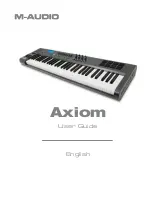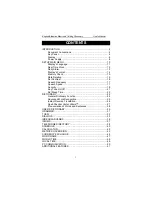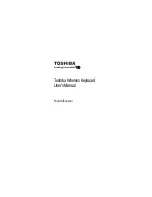
10-210
KDFX Reference
KDFX Algorithm Specifications
To determine how much to compress or expand the signal, the compressor/expander must measure the
signal level. Since musical signal levels will change over time, the compression and expansion amounts
must change as well. You can control how fast the compression or expansion changes in response to
changing signal levels with the attack and release time controls. Compression and expansion have
separate controls.
First consider the compressor. With the attack time, you set how fast the compressor responds to increased
levels. At long attack times, the signal may over-shoot the threshold level for some time interval before it
becomes fully compressed, while at short attack times, the compressor will rapidly clamp down on the
level. The release time controls how long it takes the compressor to respond to a reduction in signal levels.
At long release times, the signal may stay compressed well after the signal falls below threshold. At short
release times, the compressor will open up almost as soon as the signal drops.
For typical compressor behavior, the attack time is considerably shorter than the release time. At very
short attack and release times, the compressor is almost able to keep up with the instantaneous signal
levels and the algorithm will behave more like distortion than compression. In addition to the attack and
release times, there is another time parameter: “SmoothTime”. The smoothing parameter will increase
both the attack and release times, although the effect is signi
fi
cant only when its time is longer than the
attack or release times. Generally the smoothing time should be kept at or shorter than the attack time.
This compressor provides two compressed segments. The signal below the lower threshold is not
compressed. The compression ratio corresponding to the lower threshold sets the amount of compression
for the lower compression segment. Above the upper threshold, the signal is compressed even further by
the ratio corresponding to the upper threshold. You may use the upper segment as a limiter (in
fi
nite
compression), or you may use the two compression segments to produce compression with a softer knee
than you would get otherwise. For example, to make the algorithm a compressor and limiter,
fi
rst choose
the two thresholds. The limiter will of course have the higher threshold. Set the compression ratio for the
higher threshold to “Inf:1”. This gives you your limiter. Finally set the compression ratio for the lower
threshold to the amount of compression that you want. Either pair of threshold and ratio parameters may
be used for the upper compression segment -- they are interchangeable. Above the upper threshold, the
two compression ratios become additive. If both ratios are set to 3.0:1, then the compression of the upper
segment will be 6.0:1. Another way to think of it is as two compressors wired in series (one after the other).
Figure 10-110 Two Segment Compression Characteristic
You have the choice of using the compressor con
fi
gured as feed-forward or feedback. For feed-forward, set
the FdbkComprs parameter to “Out”; for feedback compression, set it to “In”. The feed-forward
con
fi
guration uses the input signal as the side-chain source. The feedback compressor on the other hand
uses the compressor output as the side-chain source. Feedback compression tends to be more subtle, but
you cannot get an instant attack.
The expander attack/release times are similar, though there is only one expand segment. The expander
works independently of the compressor. The expander cannot be con
fi
gured for feedback (if it could, it
would alway shut itself off permanently). The signal delay path does affect the expander. The attack time
is de
fi
ned as the time for the expansion to turn off when the signal rises above the threshold. This time
should be very short for most applications. The expander release time is the time for the signal to expands
down after the signal drops below threshold. The expander release time may be set quite long. An
In Amp
Out
Amp
Threshold 1
Threshold 2
Summary of Contents for K2661
Page 18: ...2 4 LFOs LFO Shapes...
Page 34: ...3 16 DSP Algorithms...
Page 54: ...5 4 MIDI Note Numbers Note Numbers for Percussion Keymaps...
Page 72: ...7 10 System Exclusive Protocol K2661 System Exclusive Implementation...
Page 82: ...9 4 Upgrading Sample Memory Choosing and Installing a SIMM for K2661 Sample Memory...
Page 334: ...10 252 KDFX Reference KDFX Algorithm Specifications...
Page 340: ...11 6 Glossary...
Page 382: ...12 42 Triple Modular Processing Alphanumeric Buttonpad Entries for DSP Functions...
Page 392: ...B 6 SysEx Control of KDFX MSB and LSB...
Page 442: ...D 20 Contemporary ROM Block Objects Controller Assignments Contemporary ROM Block...
Page 490: ...H 12 General MIDI Standard Mode Controller Assignments...
Page 492: ...I 2 Live Mode Objects Live Mode Programs...
Page 498: ...K2661 Musician s Reference Index...
Page 500: ......
















































